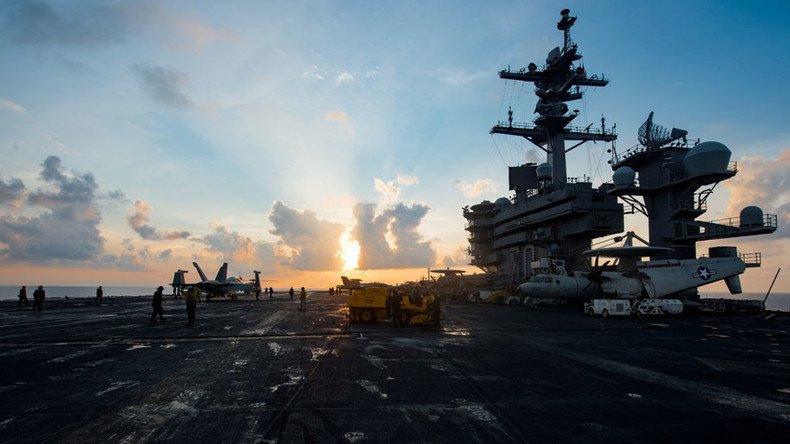Trump’s Navy expansion plan would cost $102 billion a year – study

The estimated cost of simply constructing a 355-ship Navy fleet would average $27 billion per year over the next 30 years, add in crew and operating costs and its plan would cost $102 billion a year, according to CBO study.
Those costs would represent a 60 percent increase on what the Navy has spent over the past 30 years, according to a study released by the Congressional Budget Office (CBO) on Tuesday.
Expanding the Navy was first broached in a new force assessment document released in December 2016. The House subcommittee on Seapower and Projection Forces tasked the CBO with estimating the costs of achieving the Navy’s objective within 15, 20, 25, or 30 years.
When the CBO studied the plan for a 15-year build-up, “its operation and support costs would be the highest among the four alternatives, primarily because it would require operating a larger fleet for a longer period of time than the other three,” the report states. The agency concluded, however, that among the alternatives, the differences in cost are “relatively small.”
Navy's 355-Ship Fleet Goal Would Cost $25 Billion Per Year, CBO Says https://t.co/QafkAhfFOo
— JuVi (@SciteCito) February 26, 2017
In March, US President Donald Trump said that after years of endless budget cuts that have impaired US defenses, he was calling for one of the largest defense spending increases in history.
“In these troubled times, our Navy is the smallest it’s been since World War I. Don’t worry, it’s going to soon be the largest,” Trump said in March, announcing his Navy expansion plan.
#Trump calls for 12-carrier #Navy. US currently has 10 aircraft carriers https://t.co/j8Mo5BLa2lpic.twitter.com/8P5rvtQu6V
— RT America (@RT_America) March 2, 2017
To achieve the goal, the Navy would have to purchase 329 new ships over 30 years. Arming the ships would mean adding fixed-wing aircraft and helicopters, plus weapons and unmanned systems.
“In addition to the costs of building 329 new ships, a larger fleet would cost more to operate: More ships would require more sailors; recruiting and training those sailors would require more civilian and military positions onshore; additional ships would lead to larger maintenance budgets; and those extra ships and crews would consume more fuel and supplies, during both training exercises and deployments,” the report states.
There would also be costs for improving the shipyards that would be needed to build the ships at higher rates.
The Navy’s new ship construction is performed by five large and two smaller private shipyards. Enlarging the fleet would place higher demand on the shipbuilding services of those shipyards. Over the past decade, the US Navy has purchased an average of 8.3 ships a year
“To meet demand, all seven shipyards would need to make improvements to their infrastructure in order to build ships at a faster rate,” according to the report.
The report concluded that workforces would have to be increased by about 40 percent over the next 5 to 10 years. Infrastructure costs would be an estimated $4 billion to achieve higher production.
The CBO’s projection of the steep increases for operating a larger fleet “would grow faster than general inflation in the economy.”
To achieve the goal would require an average construction rate of 11 ships per year over 30 years.
The Navy and Air Force also have a problem with aging nuclear weapons.
“Our nuclear deterrent is nearing a crossroads,” US Air Force General Paul Selva, vice chairman of the Joint Chiefs of Staff, told the House Armed Services Committee in March. “We are now at a point where we must concurrently modernize the entire nuclear triad and the infrastructure that enables its effectiveness.”
Ohio-class submarines, Minuteman III ballistic missiles, and B-52 strategic bombers are all rapidly approaching the end of their useful lifespan, according to Selva and three other senior officers testifying.
The B-52 fleet was built in the 1950s, and the bombs and missiles they use were designed and built in the 1970s with a 10-year lifespan, Selva said.
Trillion-dollar pitch: US #nuclear triad too old to fight #Russians, #Pentagon says https://t.co/XyRoHSlkyipic.twitter.com/9mb84pfmnm
— RT America (@RT_America) March 8, 2017
The Obama administration put the price tag of modernizing the US nuclear arsenal at $355 billion by 2023. Critics have said the actual figure could rise to over $1 trillion. President Trump has called for the US to “greatly strengthen and expand its nuclear capability,” though he criticized the Obama administration’s costly modernization program during the election campaign.
The US Navy currently employs 106,000 men and women to operate combat ships in its 275-ship fleet and incurs about $23 billion per year in direct operations and support costs. There are another 7,600 in military and civilian personnel.













